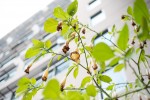This post was updated Feb. 12 at 3:15 p.m.
Campus Queries is a series in which Daily Bruin readers and staff present science-related questions for UCLA professors and experts to answer.
Q: The yellow flowers near Sproul Cove are poisonous. Are they dangerous to students?
A: The Brugmansia, or angel’s trumpet, is toxic and can induce hallucinations and unconsciousness – but only if ingested.
The plant, characterized by its upside-down, trumpet-shaped and brightly colored flowers, can be found outside of Rieber Hall and Sproul Hall.
Matthew Richard, a second-year political science student, cut a couple of the flowers in fall and put them in a mug in his room for decoration. He threw them away after a friend visiting from UC Berkeley told him they were poisonous. Richard said he told his resident assistant about the dangers of the plant.
However, the plant is not harmful if simply touched, said Wayne Dollase, a professor emeritus in the earth, planetary and space sciences department. Picking the flowers and storing them may not necessarily be dangerous.
“I’ve been here for 52 years and never heard of anyone on campus ingesting a plant,” Dollase said.
He said a doctor once told him he treated many patients for ingesting or smoking parts of the angel’s trumpet. The doctor said while none of the patients died, they all needed substantial medical care. Every part of the plant is toxic, especially the seeds and leaves, Dollase said.
The plant contains scopolamine, a compound that is used in medicine to treat motion sickness but can be toxic in high doses. The compound blocks small molecules in the brain that help carry signals from neuron to neuron.
A report published in 2014 in BioMed Central Research Notes said symptoms can start developing within five minutes of ingestion. At lower doses, people can experience incoherent thoughts and hallucinations, while at higher doses, people can experience paralysis and convulsions. According to the report, eating 10 flowers can be fatal, although the concentration of scopolamine can vary from plant to plant.
The authors said a 64-year-old woman garnished her breakfast with angel’s trumpet petals without knowing its toxicity. After eating the petals, she immediately had difficulty speaking and experienced confusion and disorientation. A day after eating the petals, she only partially remembered the events following ingestion.
In the 1920s, the CIA used the plant and the hallucinations it induced to draw confessions from people, Dollase said.
“Apparently the trip is so terrifying that they will tell the interrogators anything,” he said.
Evan Meyer, the assistant director for the Mildred E. Mathias Botanical Garden, said the plant evolved these toxins to prevent bugs from eating it.
Mayer said the flowers are planted to decorate the landscape, not to be eaten.
Nurit Katz, the chief sustainability officer at UCLA, said landscapers consider many variables such as aesthetics and drought tolerance when selecting plants for the Hill.
She said many plants native to California are toxic, and she hopes students will have enough common sense to research a plant before ingesting it.
